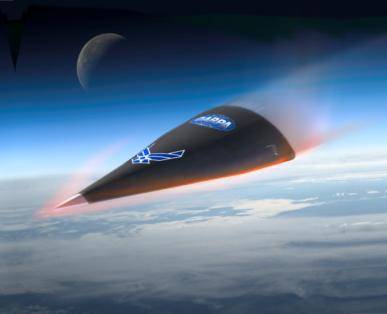ScienceRocks
Democrat all the way!
- Banned
- #1
Hypersonic plane to fly at 20 times speed of sound
Hypersonic travel almost a reality
Within four years we'll be able to travel anywhere on earth in an under an hour. At least that's the hope of the US military as it spearheads technological development and flight tests X-planes.
The US military aims to fly a hypersonic plane at 20 times the speed of sound by 2016.
The X-plane will travel at Mach 20 (roughly 20,900 km/h), which means it could fly to any place on earth in less than an hour.
We have the opportunity to usher in a new area of flight.
Christopher Schulz
The project, titled Integrated Hypersonics, is being carried out by the Defense Advanced Research Projects Agency (DARPA), which has developed stealth aircraft for the US government for over 30 years.
The X-plane will travel at roughly 20,900 km/h. Photo: DARPA
"We have the opportunity to usher in a new area of flight more rapidly," said US Air Force Major Christopher Schulz, who is also the program manager at DARPA. "And in doing so, develop a new national security capability far beyond previous initiatives."
According to the government agency, the project comes in response to the US's military advantage being threatened by other nations' increasing abilities in stealth and counter-stealth warfare.
DARPA has conducted two test flights of prototype hypersonic aircraft in the past two years. In August last year, the Falcon Hypersonic Technology Vehicle 2 (HTV-2) reached Mach 20, but only remained airborne for nine minutes.
Read more: X-Plane: Hypersonic Flight: Aeronautics: US Military, Defense Research
---
This is why we have all this cool stuff we use in our daily lives. Through research and pushing mankind to his very best...Worth every fucking cent. This is how we remain NUMBER ONE!


DARPA Falcon Project - Wikipedia, the free encyclopedia
----
The program's research will focus on five key areas: thermal protection system and hot structures; aerodynamics; guidance, navigation and control (GNC); range/instrumentation; and propulsion.
Thermal protection is a crucial issue for hypersonic flight, which is defined as anything over Mach 5. A vehicle flying inside the atmosphere at Mach 20 would experience temperatures in excess of 1920 degrees Celsius - hot enough to melt steel. The project will also aim to improve design and manufacturing processes, in order to able faster production.
"We do not yet have a complete hypersonic system solution," said Gregory Hulcher, director of strategic warfare at the Office of the Under Secretary of Defence for Acquisition, Technology and Logistics.
"Programs like Integrated Hypersonics will leverage previous investments in this field and continue to reduce risk, inform development, and advance capabilities," he said.
A new launch vehicle will be designed for the hypersonic aircraft, rather than adapting an existing rocket booster that was designed for space missions, DARPA said. Rocket propulsion technology will also be integrated into the vehicles to give a mid-flight rocket boost that would extend the range of the flight.
Proposed advancements in aerodynamics and GNC technologies will allow the X-plane to make in-flight adjustments to deal with changing external conditions, increasing the safety of the vehicles.
Moving forward, the program will conduct further ground tests and test flights of prototype vehicles, as well as modelling and simulation that will culminate in a full-scale flight of the X-plane in 2016.
DARPA will host an event on August 14 in Arlington, Virginia, to detail the areas for which technical and research proposals are being sought.
Read more: X-Plane: Hypersonic Flight: Aeronautics: US Military, Defense Research
Hypersonic travel almost a reality
Within four years we'll be able to travel anywhere on earth in an under an hour. At least that's the hope of the US military as it spearheads technological development and flight tests X-planes.
The US military aims to fly a hypersonic plane at 20 times the speed of sound by 2016.
The X-plane will travel at Mach 20 (roughly 20,900 km/h), which means it could fly to any place on earth in less than an hour.
We have the opportunity to usher in a new area of flight.
Christopher Schulz
The project, titled Integrated Hypersonics, is being carried out by the Defense Advanced Research Projects Agency (DARPA), which has developed stealth aircraft for the US government for over 30 years.
The X-plane will travel at roughly 20,900 km/h. Photo: DARPA
"We have the opportunity to usher in a new area of flight more rapidly," said US Air Force Major Christopher Schulz, who is also the program manager at DARPA. "And in doing so, develop a new national security capability far beyond previous initiatives."
According to the government agency, the project comes in response to the US's military advantage being threatened by other nations' increasing abilities in stealth and counter-stealth warfare.
DARPA has conducted two test flights of prototype hypersonic aircraft in the past two years. In August last year, the Falcon Hypersonic Technology Vehicle 2 (HTV-2) reached Mach 20, but only remained airborne for nine minutes.
Read more: X-Plane: Hypersonic Flight: Aeronautics: US Military, Defense Research
---
This is why we have all this cool stuff we use in our daily lives. Through research and pushing mankind to his very best...Worth every fucking cent. This is how we remain NUMBER ONE!


DARPA Falcon Project - Wikipedia, the free encyclopedia
----
The program's research will focus on five key areas: thermal protection system and hot structures; aerodynamics; guidance, navigation and control (GNC); range/instrumentation; and propulsion.
Thermal protection is a crucial issue for hypersonic flight, which is defined as anything over Mach 5. A vehicle flying inside the atmosphere at Mach 20 would experience temperatures in excess of 1920 degrees Celsius - hot enough to melt steel. The project will also aim to improve design and manufacturing processes, in order to able faster production.
"We do not yet have a complete hypersonic system solution," said Gregory Hulcher, director of strategic warfare at the Office of the Under Secretary of Defence for Acquisition, Technology and Logistics.
"Programs like Integrated Hypersonics will leverage previous investments in this field and continue to reduce risk, inform development, and advance capabilities," he said.
A new launch vehicle will be designed for the hypersonic aircraft, rather than adapting an existing rocket booster that was designed for space missions, DARPA said. Rocket propulsion technology will also be integrated into the vehicles to give a mid-flight rocket boost that would extend the range of the flight.
Proposed advancements in aerodynamics and GNC technologies will allow the X-plane to make in-flight adjustments to deal with changing external conditions, increasing the safety of the vehicles.
Moving forward, the program will conduct further ground tests and test flights of prototype vehicles, as well as modelling and simulation that will culminate in a full-scale flight of the X-plane in 2016.
DARPA will host an event on August 14 in Arlington, Virginia, to detail the areas for which technical and research proposals are being sought.
Read more: X-Plane: Hypersonic Flight: Aeronautics: US Military, Defense Research
Last edited:


 We would of never broke a rock to make a sharp edge or developed roads, computers, satellites, houses to live comfortably. All this was developed through people thinking and carrying through with it. Life isn't worth living if we stop our forward precession. What the fuck is the purpose of life?
We would of never broke a rock to make a sharp edge or developed roads, computers, satellites, houses to live comfortably. All this was developed through people thinking and carrying through with it. Life isn't worth living if we stop our forward precession. What the fuck is the purpose of life?  You'd likely see that as something good.
You'd likely see that as something good. 
